Cash Flow Fight Club
Cash Flow. You love it. You want it! We’re all seeking it, but what’s the best way to generate it? Google Cash Flow and get instantly overwhelmed. With so much noise and marketing hype out there, how do you know which approach is the best for you? We’ve wrestled with massive amounts of research, opinions and experimentation trying to find the best methods. Now we’re on a mission to find the best methods and give you all the dirty details - Fight Club style! In our signature Fight Club matchups, we bring together the heavyweights of business and investing to debate the risks, rewards and the inside scoop on the best ways to generate life-changing cash flow that can put you on the path to financial freedom. And after battling it out in the arena over 3 rounds, we crown the Champion. We alternate Fight Club matchups by going In the Champion’s Corner, where we’ll discover what it takes to forge a champion. Mindset, high performance habits, best-in-class behaviors and more of what it takes to be successful – in your finances and in life. So whether it’s passive income, real estate, side hustles or cash-flowing business ventures, we’re bringing you all the details in the most informative and entertaining show on the airwaves. Join us to see who’ll reign supreme! Who will take home the title of Cash Flow Fight Club Champion. And the 1st rule of the Cash Flow Fight Club – hit subscribe and don’t miss even 1 battle among the titans of Cash Flow. It’s going to be epic!
Episodes
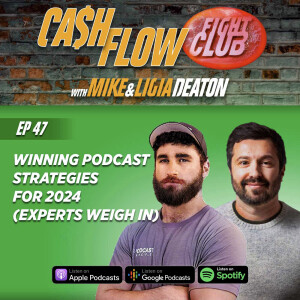
2 days ago
2 days ago
In this episode, we've got podcasting powerhouses James Bishop and Ryan Sullivan in the ring, debating strategies for podcast success from their unique perspectives.
James, founder of top UK podcast production company OneFinePlay, takes a polished, commercial approach. Meanwhile, Ryan of Podcast Principles argues for personal branding and lead generation. They'll also spar over attention spans in the age of TikTok and more!
Tune in for this battle of podcasting pros as they school us on everything from production value to platform strategies – and walk away with game-changing insights no matter your podcasting goals.
Here are some power takeaways from today’s conversation:
00:00
01:24 - Introduction
12:30 - A commercial approach to podcasting
15:30 - Podcasting for lead generation and personal branding
38:00 - Differing views on attention spans and short form content
Episode Highlights:
[12:30] A Commercial Approach to Podcasting
James' background in live events and television led him to found OneFinePlay, a podcast production company taking a polished, commercial approach. With over 15 years of experience staging large-scale productions, James emphasized the importance of audience growth metrics and high production value when clients come to him expecting tangible results. While open to experimenting with new formats, James revealed his average podcast costs between $3,000-$4,000 to produce, requiring a business model focused on profitability rather than passion projects. This commercial viability means implementing strategies to attract sponsors through growing, engaged audiences - a model necessitated by OneFinePlay's overheads and team of full-time creatives.
[15:30] Podcasting for Lead Generation and Personal Branding
While Ryan agrees audience growth is important, he argues the primary goal of business podcasts should be lead generation and personal branding. As the founder of Podcast Principles, he helps companies launch podcasts as a marketing expense rather than a business in itself. Ryan primarily focuses on LinkedIn and YouTube to attract potential clients.
The hosts debate attention spans in an age of short form content like TikTok. James is skeptical about the idea that attention spans are truly getting shorter, citing his ability to watch hours of TikTok videos in a sitting. Ryan partially agrees but also acknowledges the reality of micro content succeeding on platforms like LinkedIn, for better or worse.
[38:00] Differing Views on Attention Spans and Short Form Content
James and Ryan engage in a lively debate about the impact of platforms like TikTok on modern attention spans. While they disagree on whether attention spans have truly changed, both recognize the need to understand how different audiences are consuming media in a fragmented online world dominated by short videos and reels across social platforms.
Resources Mentioned:
OneFinePlay
Podcast Principles
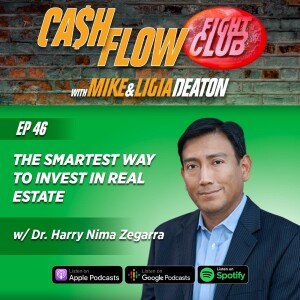
Wednesday May 29, 2024
Wednesday May 29, 2024
Want to learn from a physician who found success through real estate investing?
In this episode, we sit down with Dr. Harry Nima Zegarra, as he shares his journey and provides practical tips for evaluating investment types, selecting reliable partners, and maintaining focus during market challenges.
As an owner of 11 properties in Dallas and partner in over 1000 multifamily units, Harry has navigated it all - from long-term rentals to syndication deals. Whether you're a healthcare professional looking to diversify or simply interested in commercial real estate, this episode is a must-listen for actionable insights from an expert in the field.
Here are some power takeaways from today’s conversation:
00:00 - Introduction
02:18 - Harry's background and medical training
05:36 - Getting started in real estate with long-term rentals
16:31 - Pursuing multifamily investments and larger deals
20:40 - Finding reliable partners and navigating challenges
37:27 - Tips for different real estate investment strategies
Episode Highlights:
[02:18] From Long-Term Rentals to Apartment Syndication
Harry discusses how he got his start in real estate investing with long-term single family rentals prior to the 2008 crash. As the market became more competitive, he explored commercial options like apartment syndication. He currently owns 11 properties in the Dallas area and has interests in over 1000 multifamily units.
[20:40] Navigating Partnerships and Overcoming Challenges
Harry stresses the importance of building relationships over time before large deals. It's crucial to align with those sharing similar work ethics and values. Regular communication during both good and bad times is key, as is having complementary skill sets. Harry maintains a long-term mindset, understanding real estate inherently has ups and downs.
[37:27] Tips for Different Real Estate Investment Strategies
When considering investment types, Harry emphasizes evaluating your goals, resources, and lifestyle. Active investments in single family rentals require more hands-on work managing properties, while syndications offer a more passive approach but come with liquidity constraints as investments are locked in for 5-7 years. Harry emphasizes considering factors like how much time an investor has available, their preferred level of involvement, and understanding the differences between active and passive investments.
Resources Mentioned:
Nima Equity
YouTube: Nima Equity
www.linkedin.com/in/harry-nima-zegarra-md
![E45: Uncover the Hidden Potential of Land Notes Investing! [real estate]](https://pbcdn1.podbean.com/imglogo/ep-logo/pbblog16672981/e45_Episodic_Artworksmall_r3a8s7_300x300.jpg)
Wednesday May 22, 2024
Wednesday May 22, 2024
Are you considering investing in land notes? Want to earn above-average returns without a lot of hassle?
Our latest episode explores whether investing in real estate land notes is truly worth it. Join us as we explore the ins and outs of this investment opportunity; how it beats the stock market with lower risk; discussing the potential benefits and risks involved.
Watch or listen in to gain valuable insights into the world of land notes as passive income investments and decide if it's right for you. Investors and developers Crystal and Rick Rumer, explain how they leverage owner financing to create monthly income streams for passive investors.
Find out how you can diversify your portfolio through this set-it-and-forget-it type of real estate investment.
Here are some power takeaways from today’s conversation:
00:00
02:50 - How Crystal and Rick got into the real estate industry
09:12 - Real estate investing during financial crisis
16:12 - The flexibility of real estate investing
20:09 - What is a real estate note?
23:20 - The benefits of a note
24:30 -The importance of thorough borrower vetting and underwriting for real estate notes
32:41 - The process of transferring real estate note documentation to new investor
54:42 - The power of steady, reliable investing
Episode Highlights:
[09:13] The Power of Adaptability in the Early Stages of Real Estate Investing
When they started with real estate investing, Crystal and Rick started with fix and flips and wholesaling, taking an open-minded approach to allow each deal to guide their strategy of acquire and exit. By allowing each transaction to dictate the strategy, it helped spark their creativity and provided valuable lessons that optimized their process over time.
[20:09] What is a Real Estate Note?
A real estate note refers to the documentation involved in a property transaction that includes a promissory note, deed, and deed of trust. The promissory note outlines the terms of the loan between the borrower and lender such as the loan amount, interest rate, repayment period, and payment schedule. The deed transfers ownership of the property to the buyer. And the deed of trust provides collateral for the loan by placing a lien on the property which allows the lender to foreclose on the property if payments are missed, protecting their investment.
[23:20] The Benefits of Notes
Real estate notes provide benefits to both borrowers and investors. For borrowers, notes allow them to purchase property through owner financing without requiring strong credit or a large down payment. Investors are able to earn a fixed rate of return through monthly interest payments as outlined in the promissory note. Notes also offer limited downside risk for investors, as the property acts as collateral in case of default.
Resources Mentioned:
www.texassecurednotes.com You can contact Rick at rick@texassecurednotes.com and 817-845-6764You can contact Crystal at crystal@texassecurednotes.com and 907-342-2214Check out the charity where you can donate at: Priceless - Home (pricelessalaska.org)

Thursday May 16, 2024
Thursday May 16, 2024
Tired of the daily grind? Ever dream of being your own boss?
In this episode, Mike and Ligia share their story of transitioning from corporate jobs to becoming full-time real estate investors and coaches. After facing unexpected layoffs, they took the opportunity to reevaluate their lives and pursue their dream of financial independence through land flipping.
They discuss the mindset shifts, strategies, and lessons learned along their entrepreneurial journey.
Whether you start a side hustle or go all-in, we'll give you the mindset shifts and strategies you need to break free from the 9-5 trap and live life on your terms.
Here are some power takeaways from today’s conversation:
00:00
01:43 - Traumatic job loss sparks career change
03:18 - Rethinking traditional retirement
04:23 - Research leads to discovering land investing
09:07 - Overcoming self-doubt and limiting beliefs
12:55- Importance of coaching and taking consistent action
16:18 - The formula for change and success
19:14 - Choosing between side hustle and full commitment
23:37 - A coaching program for land investing
Episode Highlights:
[04:23] Discovering Land Investing
Mike details how he first discovered land investing through podcast research years prior. When he and Ligia unexpectedly lost their jobs, it gave them the flexibility to fully commit to their new venture. They decided to try land investing for 12 months, treating it as a full-time job. With help from a coaching program, they were able to achieve early success through dedicated action-taking.
[09:07] Pushing Through Mental Struggles
Ligia shares the mental struggles of transitioning from a steady paycheck to being fully self-employed. Criticism from friends and family added to the self-doubt. She learned to push through fears of failure by focusing on small wins and drawing encouragement from their like-minded community.
[12:55] Coaching as an Investment, Not Expense
Coaching should be viewed as an investment rather than an expense. While coaching programs may have an upfront cost, the return on investment can be significant. By investing in a coaching program early on, Mike and Ligia were able to avoid costly mistakes and the success they achieved outweighed the initial coaching costs.
[13:50] The Importance of Taking Action
Mike and Ligia emphasize that taking consistent action is key to any entrepreneurial endeavor. While research and planning have value, ultimately progress happens through real-world testing and iteration. They advise starting a side business first when possible but also not being afraid to fully commit, as they did, when the timing feels right.
Resources Mentioned:
Rich Dad Poor Dad
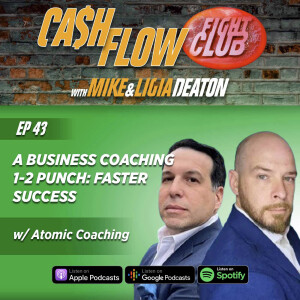
Wednesday May 01, 2024
Wednesday May 01, 2024
Are you an entrepreneur or business owner struggling with mindset barriers or operational challenges? In this episode, mindset experts Adam Hurd and Tom Marino share insights on mindset mastery, overcoming common entrepreneur challenges, and their unique collaborative coaching approach.
Learn their strategies for overcoming limiting beliefs and achieving life harmony through Atomic Business Coaching. Hear real client success stories and how small daily tasks built one man's confidence, growing his business revenues exponentially.
Here are some power takeaways from today’s conversation:
00:00
04:24 - More about Adam and Tom
09:43 - Finding harmony through purpose
15:52 - A look into their business process flow
18:15 - The value of dual perspectives in coaching
19:10 - Strategy for bringing clarity to clients
19:50 - The philosophy behind Atomic Business Coaching's approach
24:40 - The reality of uneven contribution in partnerships
45:26 - Embracing the reality of failure for success
48:15 - Embracing the reality that entrepreneurship is hard work
Episode Highlights:
[12:16] Finding Harmony Through Purpose
Tom and Adam don't believe in the concept of work/-life balance, as it sets an unrealistic standard of perfectionism. They aim to help people experience harmony by aligning their actions with their deepest motivations.
[13:41] Stepping Into Discomfort to Achieve Growth
Tom and Adam help clients expand beyond limitations by thoughtfully challenging comfort zones. They explain how their coaching brings people outside safe routines. But they don't leave clients to face new fears alone. They walk alongside, guiding clients through uncertainty. This supportive process builds momentum so businesses and lives can progress powerfully.
[15:52] Iterative Process Design for Optimal Client Outcomes
Tom and Adam have carefully designed their coaching process through iterative testing and refinement. They ensure systems can be understood by all skill levels, even children. Their 90-day trials and regular evaluations have optimized a distinct yet complementary workflow - Adam focuses on strategy while Tom addresses mindsets. This delivers value to clients.
[19:10] Gaining Clarity Through the "Believe-Behave-Become" Methodology
Tom and Adam utilize a methodology called "Believe-Behave-Become" with their clients. First, they work to help clients gain a true belief that they can accomplish their goals. Once that belief is established, they assist with behaving following this newfound confidence. If clients believe and behave a certain way, they will then become who they envision. This staged approach aims to bring clarity around priorities and actions needed to achieve business and personal success.
[24:40] The Reality of Uneven Contribution in Partnerships
Tom explains that no relationship, including business partnerships, can truly be 50/50 split. People give differently depending on their capabilities. Some days one partner may only have 20% to contribute while the other covers 80%. The key is flexibility to go back and forth in levels of participation. This understanding is important for partnerships to function effectively over time, as circumstances change for each individual.
[45:26] Embracing the Reality of Failure for Success
Adam notes that even the most accomplished entrepreneurs fail 70% of the time. Being willing to take more risks and fail more than competitors separates the highly successful. This mindset is key for entrepreneurs, as experimenting, learning from mistakes, and continually trying new approaches lead to long-term growth.
Resources Mentioned:
Atomic Business Coaching
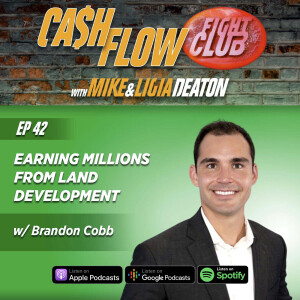
Wednesday Apr 24, 2024
Wednesday Apr 24, 2024
Real estate offers so much variety and many ways to earn outstanding returns, build wealth and generate passive income. Discover how adversity can spark success in real estate. In this episode, Brandon Cobb discusses his unexpected firing that led him to entrepreneurship. Now the owner of real estate firm HBG Capital, Brandon shares strategies for land acquisition, development approvals, and syndicating deals with investors. Plus, Brandon shares his outlook on real estate risks in 2024 and his goals to end veteran homelessness through development.
Here are some power takeaways from today’s conversation:
00:00
02:43 - Brandon’s background in sales and sports medicine
06:40 - Getting fired and deciding to pursue entrepreneurship
11:18 - Strategies for land acquisition, development approvals, and syndicating deals
20:10 - Addressing the supply imbalance for first-time homebuyers
21:09 - Leveraging technology and relationships to find development sites
33:45 - Syndicating land deals with investors to fund development projects
42:11 - Daily mindset practices and advice for handling adversity
44:15 - Outlook on 2024 real estate risks and goals to end veteran homelessness
Episode Highlights:
[04:54] An Unexpected Career Pivot and Path to Real Estate
Brandon began his career in medical device sales, enjoying his work in sports medicine. However, he was unexpectedly fired from his job one sunny Friday afternoon. Shocked and confused, Brandon decided to pursue entrepreneurship. He started a life coaching business and met his now business partner at a real estate meetup. Together, they invested in real estate deals in Colorado Springs.
[20:10] Addressing the Supply Imbalance for First-Time Homebuyers
Brandon discusses the growing opportunity in affordable housing development to address the supply imbalance for first-time homebuyers. He notes that 33% of home buyers are millennials seeking their first home, yet less than 10% of homes built cater to their price point. This creates a major supply and demand issue. Brandon also touches on how this presents opportunities for build-to-rent strategies due to the affordability of housing needed by this growing demographic.
[27:03] Leveraging Technology and Relationships to Find Development Sites
Brandon discusses his strategies for identifying land parcels for development. This includes using tools like LandGlide to map suitable properties and building relationships with local brokers and municipalities. He explains how to present initial concept plans to get verbal approvals before engaging engineers.
[33:45] Syndicating Land Deals with Investors to Fund Development Projects
Brandon syndicates land development deals with investors to fund projects. He raises capital from private investors and structures deals to purchase land through syndications. This allows Brandon to acquire land upfront while mitigating risk through equity funding rather than taking on debt.
Resources Mentioned:
HBG Capital
LandGlide
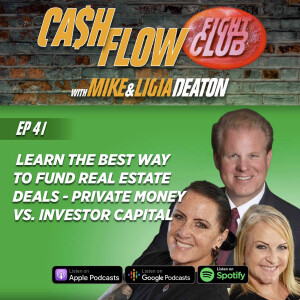
Wednesday Apr 17, 2024
Wednesday Apr 17, 2024
This episode of Cashflow Fight Club features two great models for building a successful real estate empire: private lending with Jay Conner and syndication with Jen and Stacy Konkey.
Jay shares how he financed over 500 single family rehab deals by educating private lenders on the benefits of backing his projects, providing passive investors high returns. Meanwhile, Jen and Stacy talk about how they have acquired and operated over 2,500 multifamily units by strategically raising capital from accredited investors through various structures like joint ventures and 506C funds.
Both models showcase effective ways to leverage other people's money and acquire assets at scale, proving the adage that OPM is the true superpower of real estate.
Here are some power takeaways from today’s conversation:
00:00
01:14 - Two great models to build your real estate empire
02:25 - About Jay Conner and Jen & Stacy Conkey
14:49 - Jay’s approach of raising private money through teaching investors
20:12 - Jen and Stacy’s approach to raising capital and scaling
28:12 - Eyeing new opportunities based on strategy and the economy
36:57 - Setting return expectations
43:08 - How Jay controls the terms for private lenders
Episode Highlights:
[01:14] Two Great Models to Build Your Real Estate Empire
Using passive investors' capital - Investors' money can be pooled together via a syndication to make down payments on assets by taking a limited partnership stake. The remainder comes from bank loans. This model leverages the power of syndication to purchase and operate assets like apartment buildings and mobile home parks.
100% funding using private money - One or a few individuals provide the full capital to purchase assets outright, requiring no bank or financing. This direct private funding model is often used for house flipping, where a property is purchased, renovated, and quickly resold for profit.
[14:49] How Jay Raised $2.15 Million in Private Money by Teaching Investors
After losing bank financing in 2009, Jay Connor knew he needed to change his funding strategy. Rather than desperately pitching deals to investors, he chose to educate his network on private lending. This approach allowed investors to understand the opportunity and proactively commit funds. Within 90 days, Jay’s new "teacher hat" mindset successfully attracted $2.15 million from individuals simply by leading with knowledge, not salesmanship.
[20:12] A Mindset Shift in Raising Capital
Jen and Stacy discussed their evolution in raising capital over the years. Starting from her initial struggles securing funds for small deals, Stacy shared how her mindset shifted from feeling like she was asking for money to recognizing many people have capital sitting idle and desire real estate exposure. This helped Stacy view capital raising as providing an opportunity for passive investors rather than needing funds herself. The pair has since helped many new investors overcome similar hurdles by reframing the ask as giving others a chance to put their money to work.
[36:57] Setting Return Expectations
Jen discussed the typical returns investors can expect when investing in deals with her and Stacy. While stabilized assets alone offer lower cash-on-cash returns around 5-8%, they target properties that also have value-add potential to increase cash flow and property value. This allows them to provide average annual returns on investment of 11.5-13.5% including eventual sale proceeds.
Resources Mentioned:
Jay Conner
Jen & Stacy Conkey

Wednesday Apr 10, 2024
Wednesday Apr 10, 2024
Video virtuosos Danny “Coach Danny D” DelVecchio and Chay Nott go head to head in the ultimate marketing showdown!
These two creative entrepreneurs know the power of video content but have very different approaches. Danny helps clients easily create video content for LinkedIn using virtual interviews, while Chay handles full physical production for e-commerce brands.
Tune in to see who emerges victorious in this epic clash of video business models!
Here are some power takeaways from today’s conversation:
00:00
01:05 - Introducing for Danny and Chay
05:25 - Dan and Chay’s career backgrounds
13:18 - Round 2: Current business models for video content creation
16:47 - How Danny’s virtual studio works
25:23 - Round 3: Startup cost, challenges, and returns
39:50 - Strategies for finding clients
45:25 - Price points and finding their teams
Episode Highlights:
[05:25] About Dan and Chay
Chay had no prior experience with cameras but used the pandemic downtime to intensely learn photography and videography skills on YouTube. He gained experience through many free early jobs of varying quality. Danny comes from a sales background and had an early podcast that taught him social media marketing. The podcast failed its second time, but he pivoted to coaching and saw opportunities in video content creation for clients.
[13:18] Round 2: Their Current Business Models for Video Content Creation
Danny runs a virtual studio model, conducting research-based interviews with clients and handing off editing. He shares pricing ranges from $1,000 for a starter package, up to $8,000 for premium clients. Chay handles full physical production for e-commerce brands, managing all aspects from locations to post-production. He works with brands doing $2.5-3M annually and prices his packages from $5,000-10,000 depending on content needs. Danny finds most clients through organic LinkedIn engagement, while Chay leverages the platform plus word-of-mouth and location-based Instagram hashtags.
[25:23] Round 3: Startup Cost, Challenges, Risks, and Returns
Danny and Chay both note client budget constraints and finding competent freelance help as the major challenges they face in running their video companies. Danny shares that clients often see video as a luxury rather than a necessity. Chay has invested more heavily in equipment due to physical production needs. While each has considered hiring employees, risks remain. They've relied on social media and referrals to build contractor networks. Dan and Chay are both optimistic that quality video content could deliver high returns in building brands and sales if marketed effectively.
Resources Mentioned:
Danny’s website: https://www.coachdannyd.com
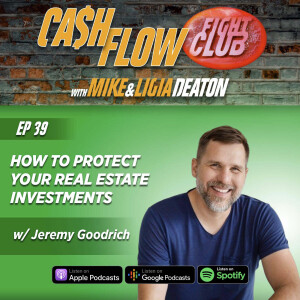
Wednesday Apr 03, 2024
Wednesday Apr 03, 2024
Are you looking to maximize returns while protecting your commercial real estate investments?
In this episode of In the Champion’s Corner, commercial real estate and insurance expert Jeremy Goodrich discusses the ins and outs of CRE investing. Jeremy shares his unique journey from elementary school teacher to insurance advisor for large CRE portfolios. He offers invaluable insights into risk management strategies, agency compliance, and navigating the changing insurance landscape.
Learn how to properly assess insurance needs for deals, avoid costly surprises at closing, and maximize returns over the long run. Tune in to hear Jeremy's advice on partnering with the right insurance professional, setting clear standards, and achieving financial freedom through entrepreneurship.
Here are some power takeaways from today’s conversation:
00:00
01:39 - Jeremey’s career background
03:45 - The value of prioritizing risk management
06:57 - Understanding agency compliance requirements
09:57 - Finding the right insurance agent
12:07 - The cost of cheap insurance
16:47 - Insurance rate increases and their impact on multifamily property investments
20:29 - Insurance claims and losses due to hail damage
29:21 - How local factors impact underwriting deals
35:13 - A mindset shift towards financial freedom
43:12 - The keys to running a business successfully with your spouse
Episode Highlights:
[03:45] Prioritizing Risk Management and Tenant Safety for Optimal Returns
Jeremy emphasizes the importance of leading a discussion around risk management when engaging investors as an insurance advisor. He wants to ensure the safety of tenants, properties, and the investor's finances. By taking a proactive approach to risk management, an investor can achieve a better return on their sleep by knowing their assets are protected, as well as a better overall ROI.
[06:57] Understanding Agency Compliance Requirements
Jeremy discusses agency compliance for Fannie Mae/Freddie Mac loans. Inexperienced agents sometimes provide cheap estimates without understanding guidelines. This often causes problems at closing. Jeremy ensures compliance upfront to avoid any insurance issues delaying the closing process, emphasizing that agents need experience with agency debt to submit compliant policies for a seamless closing.
[09:57] Finding the Right Insurance Agent for Your CRE Needs
When assessing which insurance agent is right, Jeremy recommends they be a specialist in commercial real estate who understands the industry from both an investing and advisory perspective. It's important they can explain complex insurance concepts simply and have relationships with multiple carriers so they can access the best options for clients rather than being limited to one company. Trust also plays a key role, as investors need to feel confident relying on an agent's expertise and recommendations.
[12:07] The Cost of Cheap Insurance
Jeremy shares a story of a client who chose a cheaper insurance policy over his own more expensive quote, saving $15,000 annually but having major coverage gaps. The property suffered a $500,000 loss from a fire six months later, and the client only received a $150,000 payout versus the near $500,000 they would have gotten with Jeremy's policy due to its more robust coverage. This illustrates how opting for a low price can end up costing significantly more in the long run if a claim occurs.
[29:21] How Local Factors Impact Underwriting Deals
When underwriting deals, it's important to understand how local insurance market dynamics in a specific area may impact costs. Jeremy notes factors like weather events, replacement costs, and litigation environment can vary significantly between regions. Properly assessing these local considerations is crucial for accurately gauging insurance expenses when underwriting a property in a given market.
Resources Mentioned:
https://creclarity.com/
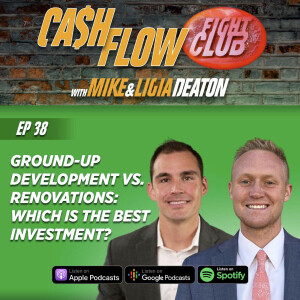
Wednesday Mar 27, 2024
Wednesday Mar 27, 2024
In this episode, real estate investors Brandon Cobb and Alec Beardhall go head-to-head to compare the alternative investment opportunities of land development versus multifamily real estate. Brandon highlights the flexibility and multiple exit options of land investing whereas Alec notes the tax benefits and passive income potential of multifamily deals.
Hear how Brandon forces value through rezoning vacant parcels while Alec increases rents and occupancy on apartment complexes. Get the inside scoop on these alternative investment strategies and learn which model comes out on top.
Here are some power takeaways from today’s conversation:
00:00
02:23 - Brandon and Alec’s backgrounds
10:14 - How apartment syndication works
14:29 - Four strategies for forcing land value growth
19:00 - The benefits of pre-selling developed land
22:32 - Ways to find their best deals
25:30 - Benefits: Land investing vs. multifamily investing
39:00 - The importance of investor experience
41:37 - Multifamily and development operations and investor communications
Episode Highlights:
[10:16] How Apartment Syndication Works
Alec explains how High Country Capital Partners does apartment syndication: they bring their own capital plus investor funds to purchase large apartment complexes. This allows individual investors to own real estate without hassles. They focus on "light value add" deals from 50-480 units, typically from 1980-2010. Investors receive 7-10% annual cash flow plus an equity payout when the property is later sold/refinanced.
[14:29] Four Strategies for Forcing Land Value Growth
Brandon outlines four ways to force appreciation in vacant land and extract value:
Force-depreciate the value of the land through entitlements like rezoning, then sell it to another developer for a profit.
Get the land entitled with utilities/infrastructure in place, then contract and pre-sell it to an end buyer who provides a down payment to fund development.
Develop the land yourself by building homes or commercial properties to sell.
Develop it and hold it as a build-to-rent community, using a multifamily-style business model to generate ongoing rental income.
[25:30] The Benefits of Land Investing
Flexibility with multiple exit strategies like reselling to another developer or building and selling homes individually. This provides more options than renting out an apartment complex long-term.
Forced appreciation locks in land value upfront before purchasing. This protects investors from market forces that could impact a multifamily property, like rising interest rates.
Investors can control 100% of the investment with no debt until development begins. This allows projects to be paused if needed rather than relying on bank financing.
Land value is secured through entitlements and engineering work done ahead of time by the sponsor. This de-risks the investment compared to taking on a multifamily property requiring renovations.
[30:27] The Benefits of Multifamily Investing
Alec highlights two main benefits of investing in multifamily real estate:
Cashflow: Investors receive a passive, recurring return of 6-8% through quarterly distributions. This provides ongoing income without needing to actively manage the property.
Tax benefits: Large tax breaks are available through depreciation deductions and cost segregation studies. These can help offset other sources of income for investors. The government incentivizes multifamily investing through these tax advantages.
Resources Mentioned:
Alec Beardall and Multifamily Investing: High Country Capital Partners
Brandon Cobb: HBG Capital
For a free e-book: Education Recourses - HBG Capital

Your Title
This is the description area. You can write an introduction or add anything you want to tell your audience. This can help potential listeners better understand and become interested in your podcast. Think about what will motivate them to hit the play button. What is your podcast about? What makes it unique? This is your chance to introduce your podcast and grab their attention.









